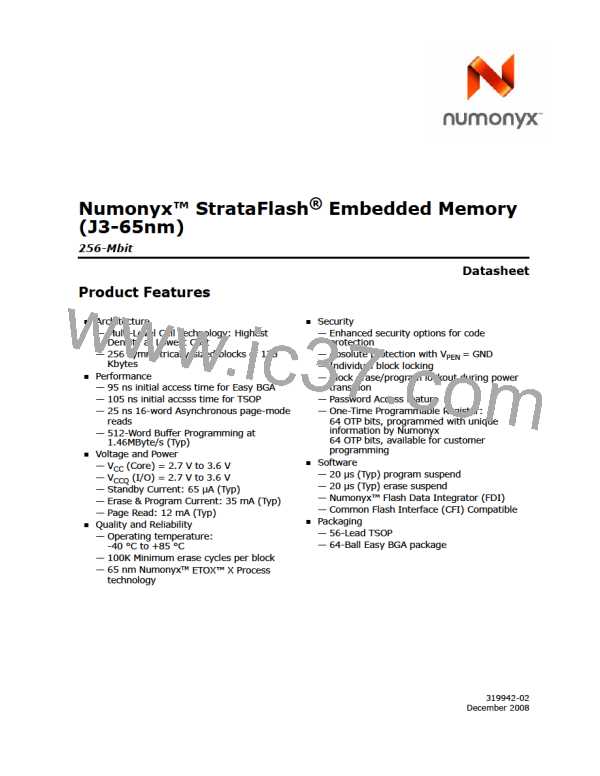®
Numonyx™ StrataFlash Embedded Memory (J3-65nm)
7.0
Read operation
The device can be in any of four read states: Read Array, Read Identifier, Read Status
Register or Read Query. Upon power-up, or after a reset, the device defaults to Read
Array mode. To change the read state, the appropriate read command must be written
to the device (see Section 6.1, “Device Command Codes” on page 18). The following
sections describe read-mode operations in detail.
7.1
Read Array
Upon power-up or return from reset, the device defaults to Read Array mode. Issuing
the Read Array command places the device in Read Array mode. Subsequent reads
output array data on DQ[15:0]. The device remains in Read Array mode until a
different read command is issued, or a program or erase operation is performed, in
which case, the read mode is automatically changed to Read Status.
To change the device to Read Array mode while it is programming or erasing, first issue
the Suspend command. After the operation has been suspended, issue the Read Array
command. When the program or erase operation is subsequently resumed, the device
will automatically revert back to Read Status mode.
Note:
Issuing the Read Array command to the device while it is actively programming or
erasing causes subsequent reads from the device to output invalid data. Valid array
data is output only after the program or erase operation has finished.
The Read Array command functions independent of the voltage level on VPEN.
7.2
Asynchronous Page Mode Read
J3-65nm supports asynchronous page mode read access only. J3-65nm also supports
Byte or Word accesses depending on the level of BYTE#.
• If BYTE# is at VIL then the data will be outputted on the DQ7-0. This read access is
called “x8 mode”. The DQ15-8 signals will be in high-z.
• If BYTE# is at VIH then the data will be outputted on DQ15-0.This read access is
called “x16 mode.”
The default read mode of the device after power up or hardware reset is read array
mode.The Read Array/ Software Reset command returns the device to read array
mode. Any following read accesses to devices returns main array data.
The page size is sixteen words (32 bytes). Each read operation internally retrieves
sixteen words of data, which are determined by addressed bits A[MAX:5].In x16 mode,
the first word of data, defined by A[4:1], is output to the data bus within tAVQV. After
this initial access time, subsequent words can be output to the data bus by changing
address bits A[4:1]. In x8 mode, the first byte of data, defined by A[4:0], is output to
the data bus within tAVQV. After this initial access time, subsequent bytes can be output
to the data bus by changing address bits A[4:0]. Any subsequent data word(s) within
the page can be output to the data bus within tAPA, which is much shorter than tAVQV
.
The internal read operation can also be initiated by asserting CEX while addresses are
valid or changing the A[MAX:5] while CEX is asserted.
December 2008
319942-02
Datasheet
21

 NUMONYX [ NUMONYX B.V ]
NUMONYX [ NUMONYX B.V ]